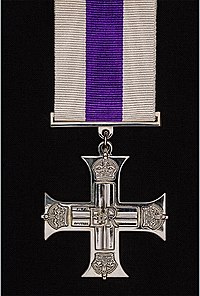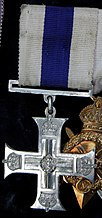Military Cross
| Military Cross | |
|---|---|
 Military Cross | |
| Type | Military decoration |
| Awarded for | ... gallantry during active operations against the enemy.[1] |
| Description | Obverse: Straight armed silver cross, Royal Cypher in centre Reverse: plain |
| Presented by | United Kingdom and Commonwealth |
| Eligibility | British, (and formerly) Commonwealth and allied forces |
| Status | active |
| Established | 28 December 1914 |
| First awarded | 1 January 1915 to 98 officers and warrant officers.[2] |
| Total | Including further awards:[3] George V: c. 43,500 George VI: over 11,500 Elizabeth II: c. 750 Charles III: 0 |
| Total recipients | 52,000+[4] |
without bar, and with one and two bars | |
| Order of Wear | |
| Next (higher) | Conspicuous Gallantry Cross[5] |
| Next (lower) | Distinguished Flying Cross[5] |
| Related | Military Medal |
The Military Cross (MC) is the third-level (second-level pre-1993)
The MC is granted in recognition of "an act or acts of exemplary gallantry during active operations against the enemy on land" to all members of the British Armed Forces of any rank.[6] In 1979, Queen Elizabeth II approved a proposal that a number of awards, including the Military Cross, could be recommended posthumously.[7]
History
The award was created on 28 December 1914 for
Awards are announced in The London Gazette, apart from most honorary awards to allied forces in keeping with the usual practice not to gazette awards to foreigners.[8]
From August 1916, recipients of the Cross were entitled to use the post-nominal letters MC,[9] and bars could be awarded for further acts of gallantry meriting the award,[10] with a silver rosette worn on the ribbon when worn alone to denote the award of each bar.
From September 1916, members of the Royal Naval Division, who served alongside the Army on the Western Front, were made eligible for military decorations, including the Military Cross, for the war's duration.[11] Naval officers serving with the division received 140 MCs and eight second award bars.[3]
In June 1917, eligibility was extended to temporary majors, not above the substantive rank of captain.[12] Substantive majors were made eligible in 1953.[13]
In 1931, the award was extended to equivalent ranks in the Royal Air Force for actions on the ground.[14]
After the Second World War, most
Since the 1993 review of the honours system, as part of the drive to remove distinctions of rank in awards for bravery the Military Medal, formerly the third-level decoration for other ranks, was discontinued. The MC is now the third-level award for all ranks of the British Armed Forces for "exemplary gallantry" on land, not to the standard required to receive the Victoria Cross (for "the most conspicuous bravery") or the Conspicuous Gallantry Cross.[15]
Description
The Military Cross was designed by Henry Farnham Burke,[16][17] while its ribbon was created by Victoria Ponsonby, Baroness Sysonby.[17]
In the Medal Yearbook 2015 it is described as follows:[18]
- 46 mm maximum height, 44 mm maximum width.
- Ornamental silver cross with straight arms terminating in broad finials, suspended from a plain suspension bar.
- Obverse decorated with Royal Cypherin centre.
- Reverse is plain. From 1938 until 1957 the year of award was engraved on lower limb of cross,[19] and since 1984 it has been awarded named to the recipient.[18]
- The ribbon width is 32 mm and consists of three equal vertical moire stripes of white, purple, and white.
- Ribbon bar denoting a further award is plain silver, with a crown in the centre.
Recipients
Numbers awarded
Since 1914, over 52,000 Military Crosses and 3,717 bars have been awarded.[4][3] The dates below reflect the relevant London Gazette entries:
| Period | Medals | 1st bar | 2nd bar | 3rd bar | Honorary MCs |
Honorary MC bars | ||
|---|---|---|---|---|---|---|---|---|
| World War I | 1914–20 | 37,104 | 2,984 | 169 | 4 | 2,909[20] | – | |
| Inter–War | 1920–39 | 349 | 31 | – | – | – | – | |
| World War II | 1939–46 | 10,386 | 482 | 24 | – | 438 | 3 | |
| Post–War | 1947–79 | 643 | 20 | – | – | – | – | |
| Total | 1914–79 | 48,482 | 3,517 | 193 | 4 | 3,347 | 3 |
In addition, approximately 375 MCs have been awarded since 1979, including awards for
The above table includes awards to the Dominions:
- In all, 3,727 Military Crosses have been awarded to those serving with Canadian forces, including 324 first bars and 18 second bars.[22]
- A total of 2,930 were awarded to Australians, in addition to 188 first bars and four second bars. Of these, 2,403 MCs, 170 first Bars and four second Bars were for World War I.[23]
- Over 500 MCs were awarded to New Zealanders during World War I and over 250 in World War II. The most recent awards were for service in Vietnam.[24]
- The honorary MC awards were made to servicemen from fifteen Allied countries in World War I, and nine in World War II.[3]
Notable awards


- During World War I, Acting Captain Percy Bentley, Humphrey Arthur Gilkes and Charles Gordon Timms, all of whose awards appeared in a supplement to the London Gazette on 31 January 1919.[28][30]
- For their key roles during World War I, the cities of Verdun and Ypres were awarded the Military Cross, in September 1916 and February 1920 respectively.[3] In May 1920, Field Marshal French presented the decoration to Ypres in a special ceremony in the city.[31]
- During World War II Captain D.T. Cowan spotted Manekshaw holding on to life and was aware of his valour in face of stiff resistance from the Japanese. Fearing the worst, Cowan quickly pinned his own Military Cross ribbon on to Manekshaw saying, "A dead person cannot be awarded a Military Cross."[32]
- The first posthumous Military Cross was that awarded to Captain Herbert Westmacott, Grenadier Guards for gallantry in Northern Ireland during the period 1 February 1980 to 30 April 1980.[33]
- The first woman to be awarded the Military Cross was Private Michelle Norris of the Royal Army Medical Corps, while attached to The Princess of Wales's Royal Regiment for her actions in Iraq on 11 June 2006. Norris was awarded her medal personally by Queen Elizabeth II on 21 March 2007.[34][35]
- Able Seaman Kate Nesbitt, second woman, first in the Royal Navy, for acts in Afghanistan in March 2009 as a Medical Assistant attached to 1 RIFLES, 3 Commando Brigade.[36][37]
- Sergeant Michael Lockett MC was the first holder of the MC to be killed in action since World War II.[38][39]
See also
- Category:Recipients of the Military Cross
- British and Commonwealth orders and decorations
- List of British gallantry awards for the Iraq War
References
- ^ "Defence FactSheet: Military Honours and Awards". Archived from the original on 17 April 2010.
- ^ a b "No. 29024". The London Gazette (Supplement). 29 December 1914. pp. 7–9.
- ^ a b c d e Abbott & Tamplin, British Gallantry Awards, 2nd ed.. pp. 220–222.
- ^ a b Jenn Stowell (9 December 2020). "All The Gen On The Military Cross". Forces Network. Retrieved 5 March 2021.
- ^ a b "JSP 761 Honours and Awards in the Armed Forces" (PDF). p. 12A–1. Archived from the original (PDF) on 2 August 2020. Retrieved 7 November 2014.
- ^ "No. 56693". The London Gazette (Supplement). 17 October 2002. p. 11146.
- ^ Abbott & Tamplin, British Gallantry Awards, 2nd ed.. p. xx.
- ^ Abbott & Tamplin, British Gallantry Awards, 2nd edition. p. 219.
- ^ Revised Royal Warrant, clause 8. "No. 29725". The London Gazette (Supplement). 25 August 1916. p. 8472.
- ^ Revised Royal Warrant, clause 5. "No. 29725". The London Gazette (Supplement). 25 August 1916. p. 8471.
- ^ Abbott & Tamplin, British Gallantry Awards, 2nd ed.. p. 217.
- ^ "The Military Cross, Royal Warrant of 25th June, 1917, amending the Third Clause of The Military Cross Warrant of 23rd August, 1916", War Office 3 July 1917 "No. 30161". The London Gazette. 3 July 1917. p. 6550.
- ^ Abbott & Tamplin, British Gallantry Awards, 2nd ed. p. 218.
- ^ "No. 33700". The London Gazette. 20 March 1931. p. 1890.
- ^ "Military Cross (MC)". Ministry of Defence. 12 December 2012 [Last updated 30 November 2021].
- ^ "The Military Cross: The New British War Decoration", Illustrated London News, vol. 146, no. 3959 (6 March 1915): 1.
- ^ a b Hoyte C. Evans, "Kitchener and the Military Cross", Journal of the Orders and Medals Society of America (March–April 1957): 14–15, accessed 3 November 2020, http://www.omsa.org/files/jomsa_arch/Splits/1957/87251_JOMSA_1957_March-April_13.pdf
- ^ a b John Mussell, Philip Mussell, Medal Yearbook 2015. p. 87.
- ^ Peter Duckers, British Gallantry Awards 1855–2000, pp. 26–27.
- ^ The World War I records are incomplete, see p. 220, British Gallantry Awards, (2nd ed), Abbott & Tamplin.
- Afghanistan, plus awards for Northern Irelandand smaller conflicts.
- ^ Veterans Affairs Canada – Military Cross (Retrieved 7 November 2018)
- ^ "Imperial Awards". It's an Honour. Australian Government. Archived from the original on 23 June 2006. Retrieved 7 November 2018.
- ^ New Zealand Defence Force: British Commonwealth Gallantry Awards – The Military Cross (Retrieved 7 November 2018)
- ^ "No. 29824". The London Gazette (Supplement). 14 November 1916. p. 11074.
- ^ "No. 30135". The London Gazette (Supplement). 15 June 1917. p. 5983.
- ^ "No. 30111". The London Gazette (Supplement). 1 June 1917. p. 5478.
- ^ a b Scott Addington; For Conspicuous Gallantry... Winners of the Military Cross and Bar during the Great War. Volume 1 – Two Bars & Three Bars, Troubador Publishing Ltd, 2006, pp. 343–352.
- ^ "No. 30901". The London Gazette (Supplement). 13 September 1918. p. 10877. (Wallington)
- ^ "No. 31158". The London Gazette (Supplement). 31 January 1919. p. 1617. (Bentley, Gilkes & Timms)
- ^ "The Award of the Military Cross to the City of Ypres, Belgium". Imperial War Museums.
- ^ Compton McKenzie (1951), Eastern Epic, Chatto & Windus, London, pp. 440–441.
- ^ "No. 48346". The London Gazette (Supplement). 20 October 1980. p. 14608. (Westmacott)
- ^ "No. 58183". The London Gazette (Supplement). 15 December 2006. p. 17359. (Norris)
- ISSN 0261-3077. Retrieved 22 March 2007.
- ^ "No. 59182". The London Gazette (Supplement). 11 September 2009. p. 15640. (Nesbitt)
- ^ "First female Royal Navy medic awarded Military Cross". The Daily Telegraph. London. 27 November 2009. Archived from the original on 11 January 2022. Retrieved 7 November 2018.
- ^ "No. 58633". The London Gazette (Supplement). 7 March 2008. p. 3613.
- ^ Norton-Taylor, Richard (22 September 2009). "Soldier Killed in Afghanistan Has Been Awarded Military Cross". The Guardian. Retrieved 17 November 2012.
Bibliography
- Abbott, Peter and Tamplin, John. British Gallantry Awards, 2nd ed. (1981). Nimrod Dix and Co., London. ISBN 978-0-902633-74-2.
- Duckers, Peter. British Gallantry Awards 1855–2000 (2011). Shire Publications, Risborough, Buckinghamshire. ISBN 978-0-7478-0516-8.
- Mussell, J. (ed.). Medals Yearbook 2015 (2014). Token Publishing, Honiton, Devon. ISBN 978-1-908828-16-3.
External links
- Original Royal Warrant for the MC Supplement to London Gazette, 1 January 1915
- Current Royal Warrant for the MC Supplement to London Gazette, 17 September 2002
- Database of Australian Awardees at the Australian Government Honours website
- Search recommendations for the Military Cross The UK National Archives
- "Military Cross". The King's Own Royal Regiment Museum, Lancaster.
- Notes on numbers awarded North East Medals



